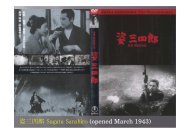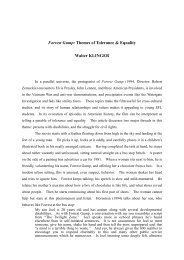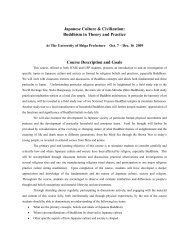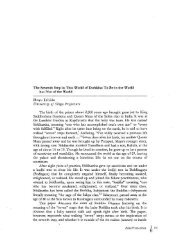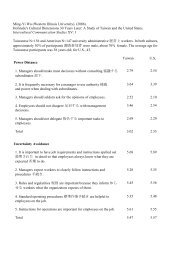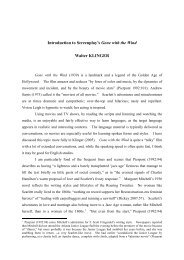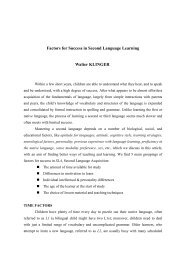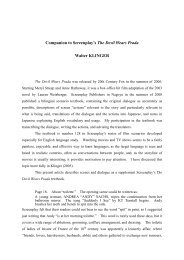14 <strong>Walter</strong> <strong>KLINGER</strong>perhaps also comes about in silence, so a sound in the silence perhaps can induce theexperience.I imagine Sanshiro’s 1965 satori could be triggered by the sound of the lotusesas they open, just as Zen master Hakuin (1685-1768)’s satori was induced by the“rin-rin-rin-rin” sound of crickets as he was reading the Lotus Sutra:The instant the sound reached his ears he suddenly became one with the deepprinciple of the Lotus Sutra. The doubts and uncertainties that had arisen at thebeginning of his religious quest and had remained with him ever since dissolved all atonce and ceased to exist. … He let out an involuntary shout and began weepinguncontrollably. (Waddell 1994).The 1943 Sanshiro looks at the full moon; a character in Kurosawa’s Rhapsody inAugust (1991) says that the moon has the power to wash the mind clean.Sanshiro mightalso see the reflection of the moon in the pond; in Buddhist concepts, as expressed, forexample, in Saigyo 西 行 (1118 - 1190)’s poems, the reflection is the reality; i.e., things are notwhat they seem to be.The mist rising from the pond adds to the ethereal effect; in practicalterms, that comes from the hot water the filmmakers poured in because Fujita Susumu 藤 田 進(1912-1991) playing Sanshiro in his career-defining role, was freezing in there in February.What brings on Sanshiro’s satori?It must be the many hours standing in the coldpond, half-awake so as not to let go of the pole and sink, his mind trying to make sense ofwhat happened with his interactions with Yano and Oshou, confusing emotions of anger, hate,and wounded pride rising and ebbing, until they are exhausted, and his body is also physicallyexhausted.His ego is then weakened sufficiently so it doesn’t interfere in an apprehensionof something beyond the self.In Zen terminology, this experience could be called satori 悟 り, a deep and intuitiveunderstanding, or perhaps kensho 見 性 , seeing one’s own true nature.thought of as Sanshiro’s baptism or initiation (Richie 1998:16). 38It could also beIn “pure experience,” says Zen philosopher Nishida Kitaro 西 田 幾 多 郎 (1870-1945),the self is nullified, “seeing without a seer, hearing without a hearer.”Experience in its original form is not the exercise of individuals equipped with sensoryand mental abilities who contact an exterior world; rather it precedes thedifferentiation into subject experiencing and object experienced (Maraldo 2005).Sanshiro’s satori is not as sudden and dramatic in the novel.Oshou comes to thepond in the morning to tell him that Yano has left without saying he has forgiven him.Sanshiro asks Oshou what he should do.Oshou tells him his judo is still lousy; Sanshiro38 I think Professor Marvel’s expression in The Wizard of Oz, “In Tune with the Infinite,” is also quite apt.
<strong>Sugata</strong> Sanshiro’s <strong>Satori</strong> 15says he knows that. Oshou says if he understands that now, to come out. 39The lotus pond experience continues to affect Sanshiro further in the story.Continuing with the 1943 film, Higaki Gennosuke 檜 垣 源 之 助 arrives at the dojo looking for afight, wearing Western clothes, long haired, mustachioed, and smoking a cigarette. 40 Hewants to marry Sayo 小 夜 , the daughter of Murai 村曪 井 , the head of the jujitsu school whereGennosuke is the star student and heir apparent. Sayo doesn’t like him. 41 Sanshiro is eagerto fight him, but he is not allowed to because he is on suspension for the brawl earlier.Some scenes later, Yano and Sanshiro see Sayo praying at a shrine. 42 Yano says:“Look; isn’t that beautiful? <strong>Sugata</strong>, do you know where that beauty in fact comes from? Inpraying, you discard your ego. In leaving your self, you become one (one mind, one heart,one thought) with kami. There is nothing mightier than this beauty. Let’s not intrude anyfurther. Oh, we have seen a wonderful thing, eh, <strong>Sugata</strong>? I feel great.” 43Kami could mean “a god,” “the gods,” “the shrine god,” or “the shrine gods.” Ithink a good translation might be “the Deific,” an adjectival form in the same way shizen maybe more of a quality than a quantifiable thing. Nishida Kitaro says, “In the religiousconsciousness, body and soul disappear, and we unite ourselves with Absolute Nothingness”39 The 1977 film follows the novel’s precedent. The 1970 Sanshiro sees lotuses, but seems more affected byseeing the sun. In the 1989 manga, the lotuses make a sound opening; Sanshiro bows at Yano’s feet. In the2002 manga, Sanshiro sees the sun rising in the east and the moon setting in the west; he rises straight up out ofthe pool like a phoenix. In the 1978 film, the other deshi jump in the pond to pull out the half-unconscious,half-frozen Sanshiro; he apologizes for making them worry. In the 1981 anime, Oshou is replaced bySanshiro’s pet cat, which he gives at the end of the story to his pal Soseki Natsume, who is destined to write anovel about it (the cat). Sanshiro is completely frozen in the pond in the morning and the deshi thaw him out.Yano scolds him that he wasted a whole night while he himself wrote a 300 page manuscript, but the cat jumpsup and knocks down the papers, revealing that they are blank. Yano admits that he couldn’t write anythingbecause he was worried about Sanshiro. Sanshiro chokes up and bows deeply at Yano’s feet; everyone sobs.Yano asks Sanshiro not to make him so miserable in the future.40 In Meiji times that was the style of both the dandy and the petty bureaucrat (Kurosawa 1983:26), but I canimagine it would catch the breath of 1943 audiences, and clearly mark him as the villain.41 One reason, I think, is the way he stubs out his cigarette in her flower arrangement. After the lotus scene, Ididn’t care for that either.42 It is recognizable as a Shinto shrine by the white zig-zag streamers, 御 幣 gohei, which may represent earlierofferings of cloth. There is just one quick glimpse of Buddhist mortuary tablets in the film, and no statues,perhaps because Buddhism was officially suspected of being a foreign, interloper religion.43見 ろ。 美 しいじゃないか。 姿 , あの 美 しさは 一 体 どこから 出 てくるか 分 かるか。 祈 るという 事 の 中 に、 己 を 捨て 切 っている。 自 分 の 我 を 去 って、 神 と 一 念 になっている。あの 美 しさ 以 上 に 強 いものはないのだ。 我 々はここで 遠 慮 しようか。あぁ、いいものを 見 たな 姿 。いい 気 持 ちだ。Miro. Utsukushii jya naika? <strong>Sugata</strong>, ano utsukushisawa ittai dokokara detekuruka wakaruka? Inoru to iu koto no naka ni, onore wo sutekitteiru. Jibun no ga wo satte,kami to ichinen ni natte iru. Ano utsukushisa ijou ni tsuyoi mono wa nai no da. Wareware wa koko de enryo shouka. Ah, ii mono wo mita na, <strong>Sugata</strong>. Ii kimochi da. “Isn’t that beautiful?” could also be read as “Isn’t shebeautiful?” This scene is also Kurosawa’s original addition to Tomita’s story, and is historically noteworthy asthe first scene he shot in his first film.



